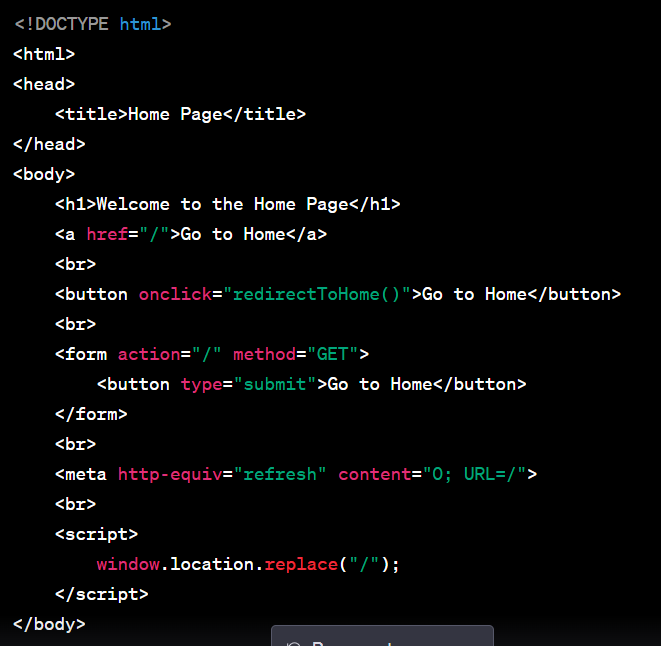Using HTML anchor tag in inside template directory
Using JavaScript window.location
Using HTML form submission
Using HTML meta refresh tag
Using HTTP 301 redirect
Using return redirect
Using return render
Using HTML anchor tag in inside template directory
To achieve the desired behavior of redirecting to the home page when clicking the "back" button, you can modify the tag in your template to link to the home page using the url template tag. Here's an example:
<a href="{% url 'home' %}">Back</a>
In the above code, home is the name of the URL pattern associated with your home page view. Replace 'home' with the appropriate URL pattern name you have defined in your urls.py file for the home page.
from django.contrib import admin
from django.urls import path
from django.urls import path,include
from loginsignup import views
from loginsignup.views import UserList
from rest_framework_simplejwt.views import TokenObtainPairView, TokenRefreshView
from loginsignup.views import GenerateAccessTokenView
urlpatterns = [
path('home/',views.HomePage,name='home'),
]
Using JavaScript window.location:
<script>
function redirectToHome() {
window.location.href = "/";
}
</script>
<button onclick="redirectToHome()">Go to Home</button>
Using HTML form submission:
<form action="/" method="GET">
<button type="submit">Go to Home</button>
</form>
In this example, an HTML form is created with the action set to the home page URL ("/"). Submitting the form will redirect to the home page
Using HTML meta refresh tag:
<meta http-equiv="refresh" content="0; URL=/">
In this example, the meta refresh tag is used to automatically redirect to the home page after a specified time (here, "0" seconds).
Using HTTP 301 redirect:
<script>
window.location.replace("/");
</script>
In this example, JavaScript's window.location.replace is used to perform a 301 redirect to the home page URL ("/").
Create a new template file myapp/home.html:
In the myapp/views.py file, create a view function to render the home template:
from django.shortcuts import render
def home(request):
return render(request, 'myapp/home.html')
In the myproject/urls.py file, add a URL pattern to map the home view:
from django.urls import path
from myapp.views import home
urlpatterns = [
path('', home, name='home'),
]
Run the Django development server:
python manage.py runserver
Visit http://localhost:8000/ in your web browser to see the home page with the different ways to redirect.
Using return redirect
Suppose you have a Django app with two views: a form view and a list view.
In your urls.py file, you define URL patterns for these views:
from django.urls import path
from .views import student_form_view, student_list_view
urlpatterns = [
path('form/', student_form_view, name='student_form'),
path('list/', student_list_view, name='student_list'),
]
In your views.py file, you implement the view functions:
from django.shortcuts import render, redirect
from .forms import StudentForm
from .models import Student
def student_form_view(request):
if request.method == 'POST':
form = StudentForm(request.POST)
if form.is_valid():
form.save()
return redirect('student_list')
else:
form = StudentForm()
return render(request, 'student_form.html', {'form': form})
def student_list_view(request):
students = Student.objects.all()
return render(request, 'student_list.html', {'students': students})
Using return render
Suppose you have a Django app with two views: a form view and a list view.
In your urls.py file, you define URL patterns for these views:
from django.urls import path
from .views import student_form_view, student_list_view
urlpatterns = [
path('form/', student_form_view, name='student_form'),
path('list/', student_list_view, name='student_list'),
]
In your views.py file, you implement the view functions:
from django.shortcuts import render, redirect
from .forms import StudentForm
from .models import Student
def student_form_view(request):
if request.method == 'POST':
form = StudentForm(request.POST)
if form.is_valid():
form.save()
return redirect('student_list')
else:
form = StudentForm()
return render(request, 'student_form.html', {'form': form})
def student_list_view(request):
students = Student.objects.all()
return render(request, 'student_list.html', {'students': students})
In your student_form.html template, you can display a form to collect student information:
<form method="POST" action="{% url 'student_form' %}">
{% csrf_token %}
{{ form.as_p }}
<button type="submit">Submit</button>
</form>
In your student_list.html template, you can display a list of students:
<ul>
{% for student in students %}
<li>{{ student.name }}</li>
{% endfor %}
</ul>
In this example, when a user submits the form in the student_form_view, the view function checks if the form data is valid. If it is, the student record is saved, and the user is redirected to the student_list_view using return redirect('student_list').
On the other hand, when the user visits the student_list_view, the view function retrieves all the student records and renders them in the student_list.html template using `return render(request, 'student_list


Top comments (0)